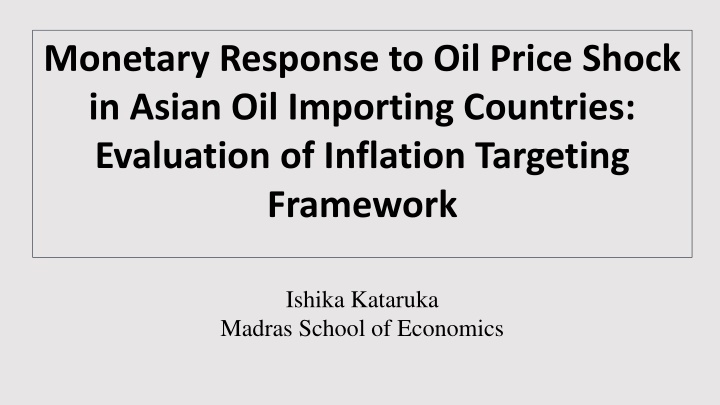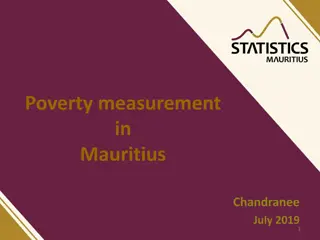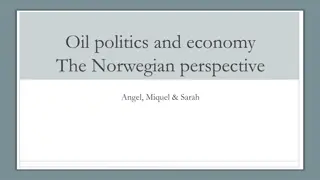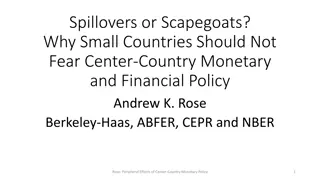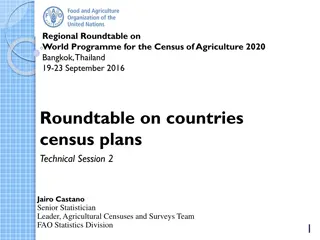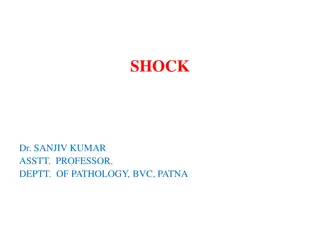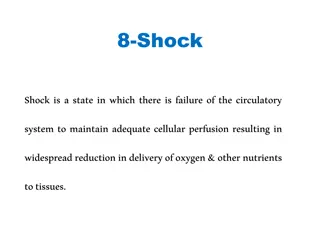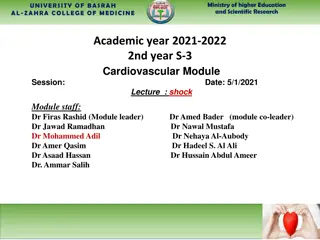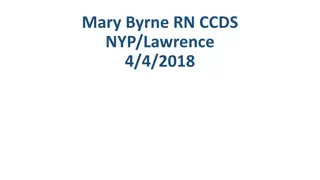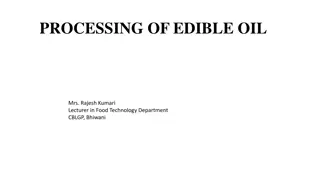Monetary Response to Oil Price Shock in Asian Oil Importing Countries
Evaluation of inflation targeting framework in Asian oil importing countries in response to oil price shocks. Examining monetary policy reactions, effectiveness of inflation targeting, and implications for macroeconomic stability.
Download Presentation

Please find below an Image/Link to download the presentation.
The content on the website is provided AS IS for your information and personal use only. It may not be sold, licensed, or shared on other websites without obtaining consent from the author.If you encounter any issues during the download, it is possible that the publisher has removed the file from their server.
You are allowed to download the files provided on this website for personal or commercial use, subject to the condition that they are used lawfully. All files are the property of their respective owners.
The content on the website is provided AS IS for your information and personal use only. It may not be sold, licensed, or shared on other websites without obtaining consent from the author.
E N D
Presentation Transcript
Monetary Response to Oil Price Shock in Asian Oil Importing Countries: Evaluation of Inflation Targeting Framework Ishika Kataruka Madras School of Economics
Background As per the BP Statistical Review of World Energy: Demand for crude oil has significantly increased by 24% worldwide in the last two decade Asian region has seen a sharp rise in oil consumption (by 36%) during 2009-2019 The region s domestic production of crude oil declined by 7% during same time period. In 2019, Asian consumed 4.5 times more oil than they produced; making Asia most dependent on imported oil than any other region. Oil is both consumption good and intermediate input to production => oil price shock has implications for growth and inflation It is pertinent to analyse the monetary responses to oil price fluctuation to maintain macroeconomic stability.
Background (contd..) EMDEs of Asia moved towards Inflation-targeting regime (IT) of monetary policy (MP) as a response to Asian financial crisis, and later, to financial crisis of 2008: Abandoned either being monetary targeting or exchange rate targeting Adopting nominal anchor (core or headline inflation) to guide MP (Mishkin,2004) Guiding Principle: Central Banks (CBs) should primarily focus on price stability as a way to achieve macroeconomic stability in the long run. How effective is MP, and in particular IT framework, for macroeconomic management in the face of oil price shock?
Objective To examine the MP reaction to oil price shock: in oil-importing Asian EMDEs India, Vietnam, Indonesia, Bangladesh and Thailand During 2008-2019 Motivation: These countries are heavily dependent on oil imports MP frameworks of these countries have changed over time Table: Monetary Policy Framework followed by Countries during 2008- 2019 Monetary Framework India Indonesia Thailand Vietnam Bangladesh Non-IT 2008-2013 2008-2019 2008-2019 IT 2014-2019 2008-2019 2008-2019 India shifted from Multiple Indicator Framework to IT framework in 2014 to foster price stability. Indonesia and Thailand shifted to IT framework in 2000 after being acutely affected by Asian Crisis (1997-1999). Note:
Literature Review Oil fluctuation can have a direct and indirect effect (Taghizadeh-Hesary, 2019): Direct Increase in production cost (Negative supply shock) Indirect Increase in export to oil exporting countries. Direct impact dominant leading to growth-inflation trade-off. However, some degree of monetary accommodation is required (Gregorio, 2012). Supply shock induces demand shock (Hamilton 1983; Abel and Bernanke 2001) Price (Inflationary Pressure) Uncertainty about future oil price Precautionary Saving Postponement of Investment AD (Greater extent ) Production cost (Negative Supply Shock) Real Income (Demand Shock) AD Oil Price CBs reacts to oil price shock to maintain price stability (Romer and Romer 1989; Castillo et al. 2010) Short/Medium Run Increase Interest Rate; to abate negative supply shock impact Long Run Lower Interest Rate; to arrest the economic slowdown by necessary demand stimulus. MP response is reason to US economy slowdown in 1970s ; not oil price increase (Bohi,1991). Existence of two-way relationship (oil prices and interest rates); depends on type of oil shock (Krichene,2006).
Literature Review (contd..) MP response to oil price shock is dependent on MP framework of country (Clarida et al., 1997; DeLong, 1997) IT CBs of developed countries managed to keep inflation (triggered by oil price rise) under control with much less increase in interest rates (Neumann and von Hagen, 2002). On the contrary, countries adopted IT framework, inclined to immediately increase interest rate to restrict inflationary pressures (triggered by oil price rise) to keep the credibility of framework intact (Filis and Chatziantoniou, 2013) In another vein, Chu and Sek(2018), find that oil price does not induce monetary policy reactions in the long run for Thailand. Thus presently there is not enough evidence on how the reaction of central bank to oil price shock play out in an inflation targeting framework vis- -vis other frameworks of monetary policy.
Methodology Taylor Rule : John Taylor (1993) proposed a rule of setting the interest rate : ?? = ??+ ???+ ? (?? ? ) + ? --- (1) Taylor model The baseline Taylor rule might be inappropriate for open economies subject to external shocks (Svensson, 2000, 2003).Taylor (2001) proposed: ?? = ?? + ???+ ? (?? ? ) + ? + ??? ---(2) Open economy Taylor Eq. (2) implies that the policy interest rate (??) goes up if inflation rate (??) is above the central bank's target inflation rate (? ) or if real income rises above its trend (??). ?? accounts for exchange rate movement. and are the weights assigned to inflation and output gap. Eq (1) is augmented to include more variables in recent empirical studies. Variables like Asset Price (Hafner and Lauwers, 2017), international reserves (Shrestha & Semmler, 2014)
Methodology (contd..) We augment Eq(2) with Crude oil price (Korhonen & Nuutilainen, 2017)in a panel data framework: Model: ? ?? ?? ?? ?? ?? ?? ?? ?? ?? ?? ?? ? = ? ?0+ ? ?1 ? ?? ?? ?? ?? ?? ?? ?? ?? ?? ?? ? + ? ?2 ? ?? ?? ?? ?? ?? ?? ?? ?? ?? ?? ? + ? ?3 ? ?? ?? ? ? ?? ?? ?? ? ? ?? ?? ?? ?? ?? ? + ? ?4 ? ?? ?? ?? ?? ?? ?? ?? ?? ?? ? + ? ?5 ? ?? ?? ?? ? + ? ?6 ? ?? ?? ?? ?? ?? ?? ?? ?? ?? ? ? ?? ?? ?? ? + ? ?? ?? ? To estimate : CBs policy response to change in oil price CBs interest setting behaviour in IT framework vs Non-IT framework by including dummy variable; takes value 1 if country follows IT at any time, otherwise 0 . CBs reacts to Oil price fluctuation differently under IT framework or not by including Oil and IT interaction term
Data Sources and Issues Our study is restricted to 5 Asia emerging oil importing countries : India, Thailand, Indonesia Vietnam and Bangladesh The data used in this study cover the Monthlyperiod from 2008-2019. The output gap, is calculated by using Hodrick- Prescott (1997) measure of trend output. We have chosen it because of its flexibility in tracking trend output (Konuki, 2010). c Table 1: Description of Variables and Data Source Variables Definition Source Interest rate Central bank Policy Rate IMF-IFS Inflation Consumer Price Index, All items, Percentage change, Previous period IMF-IFS Output Economic Activity, Industrial/Manufacturing Production, Index IMF-IFS Exchange rate Exchange Rates, Domestic Currency per U.S. Dollar, End of Period IMF-IFS Oil Price Brent crude oil, spot price in USD per barrel US EIA West Texas Intermediate (WTI), Spot Crude Oil Price in USD per Barrel US EIA Dummy variable assuming value 1 , if the country at a given period follows inflation targeting framework Dummy IMF AREAER Issues: Unbalanced panel dataset sampled at different time periods for the India and Vietnam (2008M1- 2019M12), Thailand (2009M7 2019M12), Indonesia (2008M1-2019M4) and Bangladesh (2008M1-2018M6) due to data limitations . As monthly GDP is not available, real output is proxied by IIP except in the case of Indonesia and Thailand, where this series is not available and the manufacturing index is used instead.
Panel Diagnostic Tests Table 1: Cross Sectional Dependence and Homogenous Tests Table 2: Results of Panel Unit Root Test Fisher ADF Level 4.48 Chi-square statistic First Difference 193.83*** Variables Pesaran, Yamagata Homogeneity Test Statistic 33.920*** Policy Rate 231.91*** 595.59*** Inflation Pesaran CSD Test Statistic 4.430*** 38.69*** 343.59*** Output Gap a: Null hypothesis is that slope coefficients are homogenous. b:Null hypothesis is that of cross-sectional independence. ***denotes significance as 1% level 5.84 431.96*** Exchange Rate 5.45 237.79*** Oil Price (Brent) Note :Null hypothesis assumes that all series are non-stationary Table 3 : Westerlund Panel Cointegration Test Statistic Value P-value Robust P-value Gt -3.77 0.00 0.00 Note: Cointegration panel-statistics (Pt and Pa) test the alternative hypothesis that the panel is cointegrated as a whole. Cointegration group- statistics (Gt and Ga) test the alternative that at least one element in the panel is cointegrated. The p-value for a test is based on the normal distribution while robust p-value is based on the bootstrapped distribution. Ga -1.25 0.11 0.07 Pt -2.94 0.00 0.01 Pa -3.62 0.00 0.02 Thus sample is cross-sectionally dependent with hetroskedascity and existence of long-run relationship.
Estimation Strategy Fully modified ordinary least squares (FMOLS) and the dynamic ordinary least squares (DOLS) estimators are employed as it correct for endogeneity correct serial correlation in the error asymptotically eliminates sample bias capable of handling CSD by obtaining of country specific coefficients provide unbiased, efficient and consistent estimates We then employed Panel Granger causality, under the panel vector error correction model (VECM) framework to detect the two-way causal linkages among the variables of the augmented Taylor rule equation.
Empirical Results Table 1 : Results of FMOLS and DOLS Estimations Dependent Variable: Policy Rate FMOLS DOLS Variables Coefficient Std. Error Coefficient Std. Error Inflation 0.9694*** 0.2033 0.4916*** 0.1105 Output Gap 0.0099* 0.0051 0.0085*** 0.0028 Exchange Rate 0.0002*** 0.0001 0.0002*** 0.0001 BrentOilPrice 0.0206*** 0.0056 0.0219*** 0.003 IT -0.8554*** 0.2956 -0.9574*** 0.1606 BrentOilPrice*IT -0.4281* 0.2383 -0.2399*** 0.0368 Constant 1.9584** 0.9075 2.2632*** 0.4929 R-square 0.49 0.4 Note: ***, ** and *denote statistical significance at the 1%, 5%, and 10% levels, respectively. Schwarz Information Criteria are used to decide optimal lag order, which is 1 for the models. FMOLS and DOLS models were also performed without taking the natural logarithm of the variables, and the results are consistent with the models taking natural logarithm of the variables. Taking natural logarithms in the estimation model has the disadvantages that the estimation of fixed effect is omitted and nonlinear equations are converted into linear forms, and during this transformation the actual value of data disappears.
Panel Granger Causality Table 2 : Panel Granger causality analysis (vector error-correction framework) Causing Variables Long Run Adjustment Endogenous Variables Short Run Policy Rate - Inflation Output Gap Exchange Rate Oil Price ECT Policy Rate 21.5*** 5.85** 0.12 21.1 -0.065*** Inflation 0.1 - 0.12 4.36** 5.55** -0.626*** OutputGap 0.87 10.18*** - 0.01 1.04 -0.067*** ExchangeRate 0.03 0.1 0.63 - 0.1 -0.013** OilPrice 3.25* 4.92 0.29 2.39 - -0.028*** Notes: ECT denotes the coefficient of the error correction term. ***, **, * denote significance at the 1%, 5% and 10% levels, respectively. Numbers in the short-run cells indicate chi-square statistics for Wald test. Estimation is based on 2 lags, selected by AIC and BIC criteria.
Inferences Increase in inflation and output, lead to increase in Policy rate. This finding is in line with the theoretical viewpoint of Taylor rule. Exchange rate negligible role in determining interest rate as : exchange rate is just part of transmission mechanism in policy evaluation. (Taylor, 2001) central bank strong reaction toexchange rate will worsen macroeconomic performance (Taylor, 2001) challenge brought by currency/exchange rate has been managed by intervention in FX reserve, rather than altering IR. Significant positive relationship between oil price and interest rate as:- This finding validates the premise that oil importing Asian nations face a negative supply shock, due to trade linkages (Taghizadeh-Hesary et. al., 2019), thus exerting a greater impact on inflation. Consequently, central banks raised the policy rate to maintain overall price stability.
Inferences (contd.) Interestingly, the coefficient of dummy variable, IT, representing inflation targeting framework, is negative and significant. In other words, monetary policy operating within non-IT framework is more hawkish. owing to credible and improved conduction of monetary policy (Kahn and Parrish 1998; Bernanke et al.,1999) stable inflation expectations under IT framework, resulting in fall in interest rate (Corbo et.al.,2001; Petursson, 2005). Estimated coefficient of the interaction term is negative and significant. implies that CBs reacted less aggressively to oil price fluctuation in IT framework, as compared to non-IT framework. countries with IT framework experiences lower impact of unexpected increase in inflation, caused by a shock (such as oil price shock), on inflation expectations (Neumann and Von Hagen, 2002; Choi et al., 2018).
Conclusion and Policy Implication Monetary response to oil price is investigated for five oil importing Asian economies : IN, ID, VN, TH & BD. Oil price plays an important role in the interest-rate setting process as levels of inflation is impacted. However, response of MP to oil price fluctuations hinged heavily on the MP framework of each country followed during 2008-19. Under IT, oil price fluctuations led to interest setting at a lower level than that set in other MP frameworks due to improved conduction of MP and better anchoring of inflation expectations. Thus, negative impact that monetary response can have in worsening the impact of oil price shock, is effectively contained in IT framework. This study asserts the efficacy of Inflation Targeting framework in terms of absorbing unprecedented oil shocks. Oil importing countries can successfully maintain macroeconomic stability without compromising on growth.
Thank you! Any Comments ??
